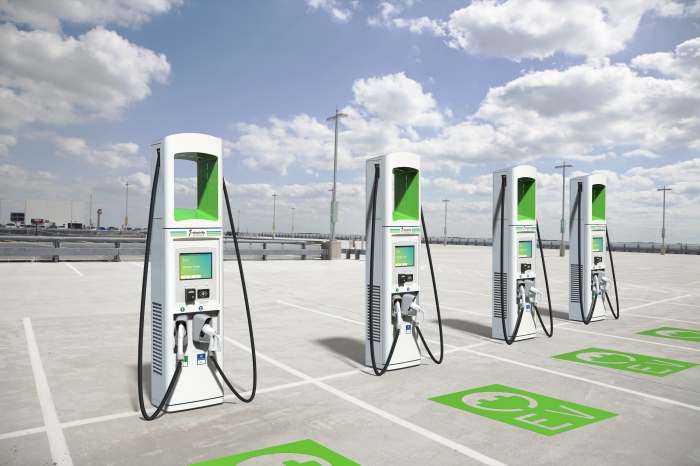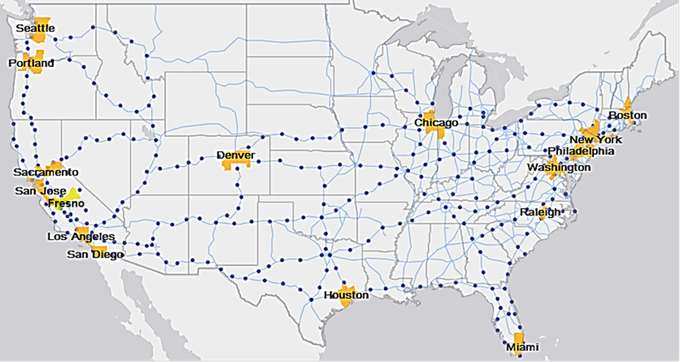 Electrify America announced today the design of their new DC vehicle chargers and the suppliers who will be making over 2,000 of them for installation in the United States. Most are expected to be completed and operational by the end of 2019 although some sites may still be under construction.
Electrify America announced today the design of their new DC vehicle chargers and the suppliers who will be making over 2,000 of them for installation in the United States. Most are expected to be completed and operational by the end of 2019 although some sites may still be under construction.
The new chargers will be installed at a total of 484 locations. Consistent with earlier plans, 17 metropolitan areas will receive community charging plazas with 3 to 6 DC chargers and usually some additional 240V AC charging equipment for cars like plug-in hybrids that often cannot use DC charging.
About 300 highway corridor locations are expected to be built in 39 states with 4 to 10 DC chargers. On average, highway locations will be spaced 70 miles apart but some rural areas may see spacing of up to 120 miles.
Most of the highway chargers will be capable of a theoretical 150 kW charging rate but some will be capable of up to 350 kW. Electrify America has previously said that about 50 highway locations in California will get a roughly 50 percent mix of 150 kW versus 350 kW chargers but at locations in the other 38 states the 150 kW versions are expected to prevail.
The DC chargers are expected to have both CHAdeMO and CCS cables and plugs which will enable essentially all DC-capable electric vehicles to charge. Tesla models S and X can use a CHAdeMO adapter to charge at near 50 kW but this adapter is not yet working with Tesla’s new Model 3 sedan. CHAdeMO is primarily required by the Nissan LEAF although a small number of other cars in the U.S. market use it as well.
Some of the chargers, such as those made by ABB, may not initially support charging at more than a theoretical rate of 100 kW on the CHAdeMO cable even though the CHAdeMO Association has already approved charging at 200 kW (400A at up to 500V). Other companies making DC chargers for the project include BTC Power, Efacec and Signet.
Charging at much more than 100 kW (200A at 500V) requires liquid-cooled cables and plugs which allows for thinner and more flexible cables that are easier for customers to use. At least one charger maker, ChargePoint (not a supplier to Electrify America), has recently stated that liquid-cooled CHAdeMO cables and plugs have not yet been fully certified in the industry.
Update: It appears that Electrify America is only initially supporting 50 kW CHAdeMO on its new chargers according to a close reading of it’s press release and the labels on the new charger photos that it released.
See also: Electrify America initially supporting only 50 kW CHAdeMO
The new charging equipment is compatible with existing vehicles which work with older 50 kW CHAdeMO and CCS chargers. Some vehicles like the Kia Soul EV and Hyundai Ioniq Electric can charge up to 70 kW or so on these new chargers but are limited to around 45 kW on existing chargers. The Chevrolet Bolt EV will be able to charge at up to 55 kW versus 45 kW.

This map shows the approximate locations of the 300 or so highway corridor DC charging locations being built by Electrify America and the 17 metropolitan areas receiving local DC charging plazas as well as slower 240V AC charging at apartment complexes, offices, and shopping centers.
Although multiple charger makers are supplying the equipment they were custom designed for Electrify America and all have a set of common features and similar design appearance. A 15-inch touch screen display includes redundant physical buttons below the screen. All chargers will have credit card readers to allow payment to be as simple and familiar as pumping gasoline at a service station.
The new locations are designed to be in areas with convenient parking and access to retail stores, restaurants, and other attractions.
“Two of the key issues impacting EV sales today are convenient charging locations and charging speeds that are not fast enough,” according to Electrify America CEO Mark McNabb. “By placing our ultra-fast charging systems in locations drivers enjoy stopping at, we help reduce charging anxiety and increase the public acceptance of electric vehicles. Dramatically increasing the charging speed by offering the first-ever certified cooled-cable 150/350kW DC Fast Chargers is also a significant step, meaning less time is spent refueling.”
Community charging is also being installed at a total of around 650 locations in 17 metropolitan areas nationwide. Some 300 of those locations would be located in and around New York City, Washington D.C., Chicago, Portland, Boston, Seattle, Philadelphia, Denver, Houston, Miami, and Raleigh. In California, a heavier concentration of charging locations would be installed in and around Los Angeles, San Francisco, Fresno, San Jose, San Diego, and Sacramento.
Funding for Electrify America, a Volkswagen subsidiary, comes as a result of legal settlements with the state of California and with the federal government related to the so-called “dieselgate” scandal. VW is putting aside a total of $2 billion which will be spent in 4 investment cycles over 10 years. Of that amount, 40 percent or $800 million is dedicated to California.
Under the agreements, VW can spend on a variety of different categories related to promoting zero-carbon tailpipe emission vehicles like all-electric and fuel-cell vehicles. Much of the money is expected to be spent on charging and refueling infrastructure. The first round of spending does not include any hydrogen fueling.
The installed equipment is owned by Electrify America and they are allowed to operate it at a profit. It cannot be installed at or adjacent to VW Group brand dealers. Volkswagen has faced separate penalties including a $2.9 billion Environmental Trust Fund that is being overseen by a national trustee but is used to support grants initiated by state, regional, and local governments.
Separately, Porsche recently announced it is working to help its 189 U.S. dealers install 350 kW chargers.
See also: Porsche gives new details on US charging
Categories: Charging




I am not too technical, but this just doesn’t feel right.
Those four charging stations all look very expensive to manufacture and to install, and there won’t be any VW electric cars in America to use them for who knows how long (none of their EVs will charge that fast for many many years. They are all under 10 kw today).
They will offer Chadamo? What for? VW EVs will have Chadamo? Going forward who is going to use Chadamo in the USA? Chadamo charging stations are really expensive, what a waste of money.
Please help me to understand this.
Beside VW owners, will everyone be allowed to use this network?
LikeLike
VW already has the e-Golf with a range of 125 EPA miles. It already supports CCS and can DC charge at around 40 kW, I think.
These stations will be usable by anyone, which is why they are supporting both CCS and CHAdeMO. Nissan continues to support CHAdeMO on their new cars and there are many LEAFS already on the road today.
The main cost of these chargers is in the external transformer that supports them and in the main charger itself that converts AC into DC efficiently. The minor extra hardware support for CHAdeMO is a relatively small additional cost — not free but relatively small.
VW Group says they will have an Audi e-tron quattro crossover for sale in the U.S. in 2019 and the Porsche Mission E which can charge at well over 150 kW is expected to arrive by the end of 2019. So, from VW’s point of view, these chargers will be available “just in time”.
LikeLike
Thank you Jeff. Seems to me only the Nissan Leaf will still use Chademo, so Chademo will most likely be dead in America going forward. I know Chademo is super popular in Japan, that’s probably why the Leaf continues with Chademo in America.
LikeLike
Nissan has the 2018 leaf with 150 miles range and a 2019 with a 225 mile range plus the losers leafs using chademo. The Mitsubishi Outlander hybrid plugin uses chademo and the Mitsubishi imev.
LikeLike
The i-MiEV is no longer sold, at least in the US. The outlander sells in relatively lower volumes and since it is a hybrid folks will most likely be depending on gasoline for long-distance driving away from their home community. I suspect the Outlander CHAdeMO is mostly used for quick metro area recharging.
That leaves the LEAF. I assume the 2019 model with a 60 kWh liquid-cooled pack will be popular. I hope so. It will be interesting to see how it works out.
LikeLike